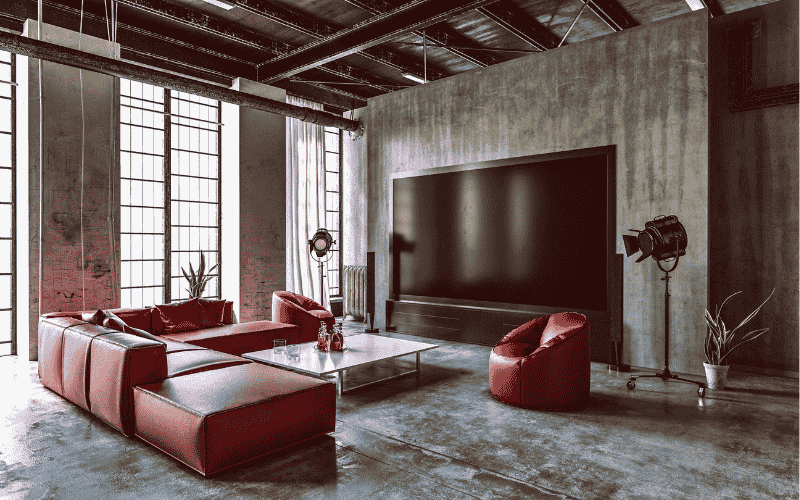In an era when streaming services reign supreme and movie theatres confront unprecedented difficulties, the allure of a personalised home cinema has never been greater. Creating the ideal home cinema experience entails more than simply installing a large screen and comfy seating; it also entails creating an immersive setting that approaches and sometimes outperforms, the traditional movie theatre.
From cutting-edge audio-visual equipment to painstakingly engineered acoustics and lighting, each component is critical in transforming a modest room into a cinematic sanctuary. The idea is to create an environment in which the borders between reality and the silver screen dissolve, allowing spectators to thoroughly immerse themselves in the world of film.
As we delve into the art of constructing the ultimate home theatre, we’ll look at how to strike a balance between technological perfection and aesthetic appeal, resulting in a room that is both functionally superior and artistically appealing. We’ll look at the major components that make up a great home theatre, from selecting the right location and equipment to incorporating design aspects that improve the viewing experience. Whether you’re a casual moviegoer or a die-hard cinephile, this guide will provide you with the knowledge and inspiration you need to build a home cinema that not only replicates the movie theatre experience but takes it to the next level. Let’s go on this trip to change a place in your home into a cinematic paradise that will be the envy of any film lover.
The Foundation: Choosing the Right Space
The quest to create your perfect home theatre begins with a critical decision that will impact every element of your viewing experience: choosing the best location. This decision is about more than just finding an empty room; it’s about identifying a spot in your home that has the potential to morph into a stunning cinematic oasis. While the luxury of a separate room designed specifically for cinematic enjoyment is ideal, many homes find the reality to be considerably more creative and motivating. Across the country, ordinary spaces are undergoing extraordinary transformations, with basements emerging from the shadows to become subterranean theatres, spare bedrooms shedding their mundane skins to reveal plush viewing lounges, and attics shedding the dust of neglect to shine as crow’s nest cinemas with views to rival any penthouse suite.

The beauty of this foundational step is its capacity to spark the imagination. Consider a basement that was formerly consigned to storage and occasional guest overflow, but is now alive with the energy of blockbuster premieres and private film noir screenings. Consider a spare bedroom, once empty and boring, but now filled with old movie posters and bathed in the gentle glow of dimmable LED sconces. Consider the attic, which was formerly nothing more than holiday decorations and forgotten souvenirs but has been transformed into a cosy refuge with slanted ceilings that create a natural amphitheatre effect, bringing the eye inexorably to the screen. Each of these transformations begins with recognising the latent possibilities in areas that we frequently ignore, transforming the ordinary into the extraordinary via the power of cinema. As we go deeper into the art of home theatre design, keep in mind that the ideal space for your cinematic aspirations could be right in front of you, ready for you to bring it to life.
Key Considerations for Your Cinema Room:
Size Matters:
When it comes to designing the ideal home cinema, size is everything. Imagine entering an environment that seems both expansive and personal, with each seat providing an unimpeded view of the screen and plenty of room to stretch out in sumptuous comfort. The golden rule of allowing at least 20 square feet per person is about more than simply physical comfort; it is about creating an environment in which each viewer feels as if they are having their own movie experience. Imagine a room where you can fully recline without invading your neighbor’s space, and where you can place that perfectly iced drink on a side table without fear of knocking it over while reaching for the popcorn. This vast amount of room is not just practical; it is also the cornerstone of a fully immersive movie experience, allowing you to lose yourself in the world on screen without being distracted by a crowded setting.
Shape Considerations:
While the basic rectangular room is the acoustic sweetheart of home cinema aficionados, don’t let a unique space destroy your silver screen ambitions. Consider converting a quirky attic with sloped ceilings into a cosy film corner, or a round turret room into a 360-degree cinematic environment. Modern acoustic treatments are nothing short of amazing, capable of calming even the most stressful environments. Consider sound-absorbing panels disguised as abstract art, diffusers that also serve as sculptural wall features, and bass traps that merge perfectly into corners. With the appropriate solutions, that awkwardly shaped space may become a unique selling feature for your home theatre, providing a viewing experience that is both unusual and immersive. Embrace the unconventional; it can lead to a very unique home cinema experience.
Light Control:
In the world of home cinema, light is both a friend and a threat. The ability to manage ambient light is not only important; it distinguishes between watching and experiencing a film. Imagine a room where, with the press of a button, the outer world slips away, enveloping you in cinematic darkness. If you are fortunate enough to have a windowless room, you are already halfway there. However, for rooms with windows, consider motorised blackout drapes or shades that glide gently into place, changing a sunny room into a pitch-black theatre in seconds. Consider sophisticated lighting systems that may simulate the illumination of a traditional movie theatre, guiding you to your seat before fading to black as the film begins. With precise light management, every viewing becomes a premiere-worthy event, with the screen providing the only lighting and pushing you deeper into the drama unfolding before you.
Sound Isolation:
The ideal home cinema is a universe unto itself, with the only sounds emanating from your cutting-edge audio system. Consider the placement of your cinema room with the same attention that a composer does for each note in a score. Basements, with their natural sound isolation, are the underappreciated heroes of home theatre settings. But don’t give up if your dream cinema must be located on a higher floor. Imagine walls lined with acoustic insulation that not only soundproofs your room but also improves the audio quality. Consider floating floors that absorb vibrations, so your late-night action movie marathon does not become your neighbour’s unwelcome alarm clock. With the correct sound isolation techniques, your home cinema transforms into an acoustic oasis where you can turn up the volume on your favourite movie without a care in the world, fully absorbed in the aural experience with no external interference.
The Heart of the Experience: Audio-Visual Equipment
At the heart of each excellent home cinema is a painstakingly built audio-visual setup, a technological symphony that elevates viewing to an immersive voyage. As we approach 2025, the field of home theatre technology continues to grow at an incredible rate, providing cinephiles with unparalleled chances to recreate—and even surpass—the magic of commercial cinemas in their own homes. While budget will always play a role in equipment selection, investing in high-quality components is not a luxury, but rather a requirement for anyone looking to produce a stunning cinematic experience. The perfect mix of visual and aural features may take viewers from their living rooms to the middle of the action, blurring the distinction between reality and the world on screen.
Visual Components:
Screen: The screen is the focal point of any home theatre and must be carefully considered. In 2025, the distinction between a huge flat-screen TV and a projector-screen combination is more complex than ever. While high-end televisions provide great image quality and convenience, projectors continue to enthral fans with their capacity to create truly theatrical experiences. Consider a wall-spanning 100-inch or larger display that transforms your space into a private cinema, with each frame representing a masterpiece waiting to be revealed. The immersive power of such a massive screen is undeniable, bringing viewers into the story with an intensity that smaller displays simply cannot match.
4K Resolution: As we navigate the visual world of 2025, 4K resolution has solidified its position as the minimum standard for home theatre fans. The clarity and depth provided by 4K monitors are simply amazing, exposing textures and nuances that transport viewers straight into the filmmaker’s vision. For those looking ahead, 8K technology is on the horizon, providing even higher visual fidelity. While content is still catching up, investing in an 8K-capable system future-proofs your setup, guaranteeing that your home theatre remains at the forefront of visual technology for many years to come.
HDR (High Dynamic Range): In the pursuit of visual excellence, HDR technology shines as a light of innovation, bringing life to every frame with its increased range of brightness and colour. HDR-enabled screens in 2025 will provide a level of colour and realism that must be seen to be believed. Imagine shadows so deep and highlights so dazzling that each scene stands out with three-dimensional clarity, bringing you closer to the director’s intended vision than ever before. From the gentle gradations of a sunset to the explosive brilliance of a sci-fi film, HDR technology ensures that every image is reproduced with astonishing accuracy and impact.
For those who want the grandeur of a projector setup, positioning is an important consideration in ensuring the best image quality. The classic ceiling mount is still popular, providing a clean, discreet installation that maximises floor space. However, the revival of rear-projection systems has created new opportunities for room design and image quality. While needing more space behind the screen, these configurations can provide better brightness and contrast, particularly in environments where ambient light control is difficult. The decision between front and back projection can significantly impact not only the visual experience but also the entire aesthetics and functioning of your home theatre room.
Audio Components:
The aural environment of a home theatre is just as important as the visual one in producing a genuinely immersive experience. In 2025, the starting point for an enveloping soundscape will be a 5.1 or 7.1 surround sound system capable of placing viewers in the centre of the action through accurate audio positioning. For those seeking the pinnacle of audio realism, object-based audio systems such as Dolby Atmos or DTS:X are the bleeding edge. These technologies go beyond typical channel-based audio, generating a three-dimensional sound environment that can properly locate noises anywhere in the space, including overhead. Consider rainfall falling from above, helicopters swooping from behind, or whispers that appear to emerge from just over your shoulder. This is the level of immersion that current object-based audio systems can deliver.
Speaker Placement: The strategic placement of speakers in your home theatre might mean the difference between mediocre and excellent quality. Proper speaker placement is an art form that combines acoustic science and the practical restrictions of your space. In 2025, new room modelling software and AI-driven calibration tools make achieving optimal speaker placement easier than ever. However, the skills of an audio professional can still be quite useful in fine-tuning your setup. Consider the precise angles, distances, and heights at which each speaker should be placed to produce a seamless, engulfing soundscape. The goal is to achieve a sweet spot in which every seat in the house provides an optimal audio experience, complete with clear conversation, impactful effects, and a seamless blend of all audio aspects.
Subwoofer: In the world of home theatre audio, the subwoofer reigns supreme as the source of deep, resonant bass that is felt as well as heard. A high-quality subwoofer (or two) is more than just an accessory; it’s a necessary component that completes the audio experience. By 2025, subwoofer technology has grown to new levels of precision and power. Modern subwoofers can recreate the lowest frequencies with incredible accuracy, from the gentle rumbling of an oncoming storm to the earth-shaking crash of an explosion. A well-tuned subwoofer’s visceral impact heightens the physicality of your viewing experience, making action sequences more exhilarating and quiet times more palpable.
Acoustic Treatments: Acoustic treatments are the final frontier in optimising the audio performance of your home theatre. Even the most sophisticated audio equipment can be hampered by bad room acoustics. Acoustic treatments will be fundamental components of home theatre design by 2025, having progressed beyond their original role. Acoustic panels, bass traps, and diffusers can be tailored to your room’s appearance while significantly increasing sound quality. These treatments operate together to control reflections, reduce echoes, and provide a balanced acoustic environment. The end effect is a better conversation, more accurate sound localisation, and a more immersive overall experience. By carefully addressing the acoustic qualities of your area, you ensure that every aspect of the audio is replicated with clarity and precision, bringing you closer to the filmmaker’s intended audio experience
Creating the Atmosphere: Design and Comfort
The ambience of your home theatre is the invisible thread that connects technology and emotion, transforming a room into a portal to other realms. Thoughtful design here is about creating a setting that stimulates every sense, preparing you for immersion. Imagine walking into a room with soft couches, acoustic panels that function as art, and lighting that creates the mood with a single button click. Consider a space where every detail, from the curvature of the ceiling to the placement of a classic movie poster, works together to suspend disbelief. This is more than just a viewing area; it’s a haven for film enthusiasts, where the lines between reality and fiction blur and each screening becomes an event to savour and remember. In this beautifully designed setting, you’re not simply watching films; you’re experiencing them in their most complete, compelling form.
Design Elements to Consider:
Seating is crucial to the comfort of your home cinema. Choose theatre-style recliners that will keep you comfortable throughout long movie marathons. For maximum convenience, look for amenities like as built-in cupholders and USB charging connections. Remember that the greatest seats don’t only feel fantastic for the first hour; they keep you comfy throughout the Lord of the Rings Extended Edition trilogy.
Tiered seats: Using tiered seats will elevate your viewing experience. This cinema-style setup ensures that everyone has a clear view, regardless of where they sit. It’s not only about viewing overheads; it’s about creating a true theatre environment in which every seat feels like the best in the house.
Colour Scheme: When it comes to the colour palette for your cinema, choose dark. Deep, rich colours on walls and ceilings are not only attractive but also effective, absorbing light and increasing contrast on your screen. Consider deep reds for timeless elegance, midnight blues for a cosmic vibe, or charcoal greys for modern sophistication.
lighting: Use smart, dimmable LED lights to set the scene. Beyond simple on/off, colour-changing capabilities can complement your movie’s tone or create pre-show ambience. Don’t overlook practical details such as subtle step lighting—it’s all fun and games until someone slips over a footrest in the dark.
Acoustic Fabric: Cover your room in acoustic fabric for a double win: better sound quality and a more opulent appearance. These specialised textiles reduce sound reflections, improving audio clarity while giving your area a velvety, premium feel. It’s like giving your ears a velvet cuddle while your eyes are fixated on the screen.
Theme: Allow your cinema to express your passions. Whether you’re drawn to the glitter of Old Hollywood, the clean lines of modern minimalism, or the otherworldly allure of sci-fi, your theme can transport you before the opening credits appear. A themed cinema is more than just a space; it is a portal to your favourite film universe.
The Brains of the Operation: Control Systems
A sophisticated control system acts as an invisible conductor, orchestrating your home cinema experience and lifting it from great to extraordinary. By 2025, these systems have grown into intuitive, all-encompassing interfaces that seamlessly combine every aspect of your theatre experience. Consider a single, beautiful remote or touchscreen that not only controls your audio-visual equipment but also regulates lighting, temperature, and even motorised seats. With a single tap or voice command, you may dim the lights, lower the screen, adjust the sound system, and begin your movie – all in perfect timing. Advanced control systems now provide personalised profiles for distinct users, remembering preferred settings for picture, sound, and ambience, allowing each family member to enjoy their perfect watching experience with no effort.
Furthermore, today’s control systems go well beyond basic functionality, adding AI-powered features that improve your cinema experience in subtle but significant ways. They can analyse your watching habits to recommend material, automatically alter audio-visual settings based on the sort of media being played, and even interact with smart home technologies to optimise the whole house for movie night. For example, they may automatically pause your video when someone rings the doorbell or change the temperature as the room fills with people. Some systems now include gesture control and augmented reality interfaces, which allow you to modify your cinema environment with a simple wave of your hand or by engaging with virtual controllers projected into your location. With these innovative control systems, your home cinema transforms from a space for watching films to a responsive, intelligent environment that anticipates your requirements and preferences, resulting in a completely immersive and personalised viewing experience.
Control Features to Explore:
Purchase a high-quality universal remote or control system to manage all of your devices easily. A smart universal remote may combine control of your television, streaming gadgets, gaming consoles, and audio equipment into a single, simple interface. Look for features such as programmable macros, smart home connectivity, and voice control to ensure a really seamless experience. With a universal remote, you can say goodbye to the clutter of many remotes and welcome to easy management of your whole entertainment system.
Select your system to change lighting, and lower screens, and select the ideal audio levels with a single button click. Home theatre automation elevates the ease of a universal remote to the next level. With a few taps, you may construct bespoke “scenes” that activate many components at once. Imagine pushing “Movie Night” and having your projector screen descend, the lights lower to create the ideal ambience, and your surround sound system turn on and switch to the appropriate connections. Automation eliminates the need to juggle many remotes, ensuring that your theatre is always ready for a play with no effort.
Smart Home Integration: Connect your cinema system to your whole smart home setup for a completely connected experience. Add voice control for hands-free operation. Voice commands provide another level of ease to your home theatre experience. With a voice-enabled universal remote or smart speaker integration, you can control your system without moving a finger. Simply ask your voice assistant to turn on the TV, switch channels, adjust the volume, or launch specific content. Voice control is especially beneficial when your hands are busy or you’ve settled in for a long movie marathon. It adds the ease of voice assistants to your home theatre, providing a really simple entertainment experience.
Connect your movie system to your whole smart home setup for a genuinely connected experience. By combining your home theatre with your smart home system, you can create a unified ecosystem in which all of your devices interact flawlessly. This enables you to manage your lighting, climate, security, and entertainment from a single interface. Consider adjusting the temperature, closing the shades, and beginning a movie with a single command. Smart home integration improves your home theatre experience by making it a seamless component of your connected home.
Conclusion: Your Personal Cinema Paradise
Creating the ideal home theatre requires a combination of personal preferences, technical understanding, and artistic vision. While it takes time and effort, the result is a space that brings the magic of cinema into your house, offering numerous hours of enjoyment and creating memorable memories with family and friends. Remember that the finest home cinema is one that reflects your tastes and improves your viewing experience. Whether you’re a casual moviegoer or a die-hard cinephile, with careful design and attention to detail, you can build a home cinema that approaches or even outperforms the greatest commercial theatres. Lights, camera, action—in the comfort of your own home!


